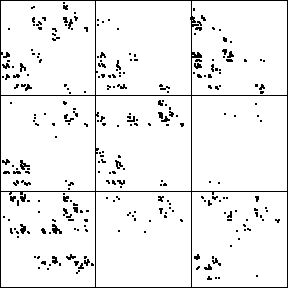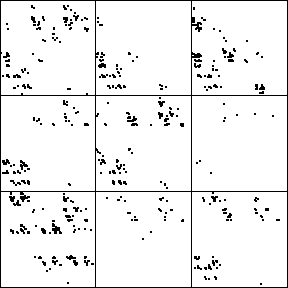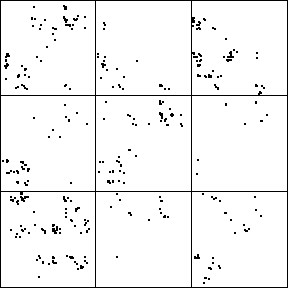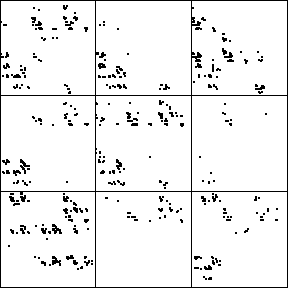| The order of the transformations is determined by the order in which the
phonological categories occur in the text, according to this correspondence. |
| T7: plosives | T8: syllabic boundaries | T9: word boundaries |
| T4: nasals | T5: fricatives | T6: affricatives |
| T1: vowels | T2: glides | T3: liquids |
|
| Some analysis |
| In all four the squares 22, 32, 42, 52, 62, 72, 82, and 92 are empty: only a vowel can follow a glide. |
| In all four, 23 and 26 are empty: a glide cannot follow a liquid or an affricate. |
| In all four, among *8 (for * = 1, ..., 7) the most filled in are 58 and 78: syllables
begin with fricatives or plosives more often than with other phonemes. |
| Among *9 the most filled are 19, 59, and 79: words begin with vowels as often as with
fricatives or plosives. |
| In all four, among 8* the most filled is 81: syllables are more likely to
end with vowels. |
| The common sonority profile is an arc: often a syllable begins with a low sonority phoneme,
followed by one of higher sonority, then lower. |
831 is more densely filled than 871: after a vowel a syllable is more likely
to end in a nasal than in a plosive. |
781 is densely filled: after a syllable ends with a vowel the next syllable can start with a
plosive. |
| The rules governing nasals and liquids are similar: in each of the four plots,
the pattern in square 3 is similar to that in square 4. |
| In each of the four plots, the pattern in 5 is similar to that in 7 (6 also is
similar, though much less filled), indicating that the three subcategories of obstruents
behave similarly. |
| Although 57 and 75 are fairly populated, 55 and 77 are not, and in general the
pairs ii are (nearly) indicating that only
rarely do two phomemes of the same phonemic category occur adjacently within a syllable. |
| Finally, the patterns in 8 and 9 are similar, thought 9 is more filled, indicating
many one-syllable words. Althought the sonority profile refers to a syllable rather than to a
word, this shows the same pattern of sonority near a syllable boundary
is repeated at word boundaries. |
|



